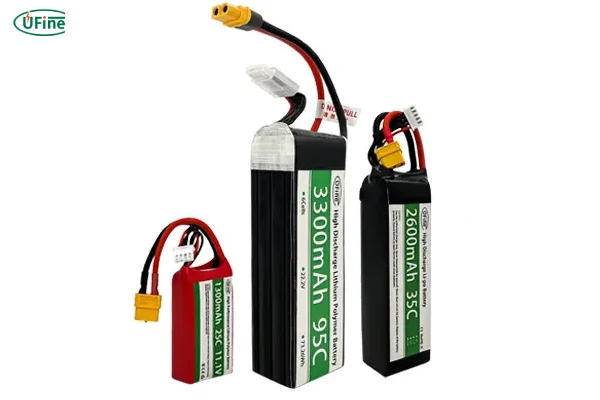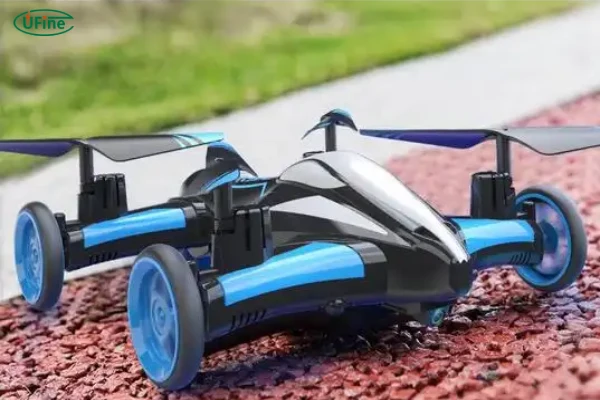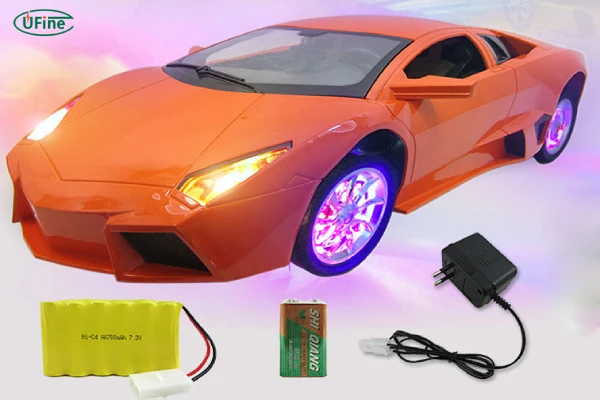For enthusiasts of radio-controlled (RC) vehicles, batteries are more than just a power source. They’re the beating heart of your RC model, impacting everything from speed and power to handling and endurance. Selecting the right battery can be challenging with so many specifications, from voltage and capacity to chemistry and configuration. Let’s dive deep into what you need to know about radio control batteries to make the best choice for your model.
Part 1. Types of radio control battery
RC batteries vary widely in performance, lifespan, and weight based on their chemical composition. Let’s explore the primary types and their unique strengths and weaknesses:
-
Nickel-Cadmium (NiCd): These batteries are durable and resistant to overcharging and deep discharge, giving them a longer lifespan. NiCd cells are robust, making them reliable for RC cars and trucks that can handle extra weight. However, their memory effect and environmental concerns due to cadmium have reduced their popularity over time.
-
Nickel-Metal Hydride (NiMH): NiMH batteries improved on NiCd’s flaws, offering higher energy density and a lower environmental impact. They provide a longer runtime than NiCd and don’t suffer from memory effects, though they can be heavier. NiMH batteries are widely used in RC vehicles that can afford a bit of extra weight, making them an affordable and versatile choice for many RC applications.
-
Lithium-Polymer (LiPo): These have become the go-to battery for high-performance RC applications. LiPo batteries are light, powerful, and can deliver high energy density, making them ideal for speed, endurance, and agility in drones, planes, and high-speed RC cars. However, they require careful handling due to the risk of fire if punctured or overcharged. LiPo’s power-to-weight ratio makes it the perfect choice for enthusiasts looking for top-tier performance.
-
Lithium-Ion (Li-Ion): Less common than LiPo, Li-Ion batteries are valued for their stability and extended cycle life. They don’t provide the same energy density as LiPo batteries but are safer and suitable for models where longevity is more important than sheer power output. They’re especially useful in high-endurance applications, like long-distance RC planes.
-
Lithium Iron Phosphate (LiFePO4): Known for safety and stability, LiFePO4 batteries are durable and can last for thousands of charge cycles. Although not as powerful as LiPo, they are less prone to overheating and are safer to charge and handle, making them an excellent choice for applications where stability and longevity matter.
NiMH Battery vs Li-Ion Battery vs NiCad Battery: How are they different?
Part 2. Basic components
Understanding the inner workings of RC batteries can help you make better-informed decisions and manage your battery effectively:
-
Cathode (Positive Electrode): This component stores ions during the charge and releases them during discharge, providing power to your RC vehicle. In lithium-based batteries, this is typically a lithium metal oxide.
-
Anode (Negative Electrode): The anode stores lithium ions when the battery is charging. During discharge, it releases electrons through the external circuit, powering the device.
-
Electrolyte: This medium allows ions to flow between the anode and cathode. Depending on the battery type, the electrolyte may be a liquid or a gel, and its composition affects safety, power output, and cycle life.
-
Separator: This thin layer keeps the anode and cathode from coming into direct contact, preventing short circuits. While it allows ion transfer, it prevents the battery’s internal components from touching.
Part 3. Shape, size, and weight
RC batteries come in a range of shapes and sizes to fit various model types, from compact drones to larger RC cars and planes. The most common shapes include rectangular packs for LiPo batteries and cylindrical forms for NiMH or Li-Ion batteries.
- Weight: LiPo batteries are lightweight, which makes them highly suitable for aerial models like drones, where every gram matters. NiMH and NiCd batteries are heavier and bulkier, better suited for ground RC models that can handle the extra weight.
Choosing the right battery size and weight is essential. A heavy battery may improve runtime but can negatively affect speed, handling, and agility, especially in lightweight models like drones and planes.
Part 4. What do “S” and “P” mean on the radio control battery?
When looking at battery packs, you may see specifications like “3S” or “4S2P.” Here’s what these terms mean:
-
S (Series): This denotes the number of cells connected in series within the pack. When cells are connected in series, the voltage increases while the capacity remains the same. For instance, a 3S battery has three cells in series, each with 3.7V, giving a total of 11.1V.
-
P (Parallel): This indicates the number of cells connected in parallel, which increases the battery’s capacity. For example, a 4S2P battery means four cells in series to increase voltage and two in parallel to boost capacity.
Part 5. Voltage
Voltage plays a significant role in determining the power output of an RC battery:
- NiMH and NiCd batteries offer about 1.2V per cell, with typical packs ranging from 7.2V (6-cell) to 9.6V (8-cell).
- LiPo batteries provide 3.7V per cell. Common configurations include 7.4V (2S), 11.1V (3S), and 14.8V (4S).
- LiFePO4 batteries have a nominal voltage of 3.2V per cell, so a 4S pack would offer approximately 12.8V.
Part 6. Capacity
Capacity, measured in mAh (milliampere-hours), determines how long a battery will last on a single charge. Higher capacity means longer runtime, but it often comes at the cost of additional weight.
- For casual RC models, a 2000-5000mAh battery is common.
- High-performance drones or planes may require 4000mAh or more for extended flight times.
Part 7. Price
Battery prices can vary widely depending on several factors:
- Type: LiPo batteries generally cost more than NiMH or NiCd due to their high performance.
- Capacity: Higher capacity packs are more expensive due to their extended runtime.
- Voltage: Higher voltage packs (more cells in series) cost more due to increased energy output.
- Brand: Premium brands charge more for quality assurance and reliability.
- Cell Quality: Some batteries use higher-quality cells for durability and performance, reflected in the price.
Price Range:
- NiMH: $10 to $30 for moderate-capacity packs.
- LiPo: $20 to $100 or more, depending on voltage, capacity, and brand.
Part 8. Applications
RC batteries power a wide range of RC models:
- Cars and Trucks: NiMH and LiPo batteries are popular for speed and torque.
- Drones: LiPo batteries are essential for lightweight and high-power needs.
- Boats: Larger capacity batteries are ideal to ensure prolonged runtime on the water.
- Airplanes: Lightweight LiPo batteries maximize flight time and performance.
Part 9. Buying badio control batteries: key considerations
When choosing an RC battery, consider the following:
- Voltage: Ensures compatibility with your model’s power requirements.
- Capacity: Determines runtime—higher is better for longer play.
- C-Rating: High C-ratings deliver faster discharge for improved acceleration.
- Weight: Affects speed and maneuverability.
- Battery Type: Choose based on performance, durability, and cost.
Part 10. Is the radio control battery rechargeable?
Yes, most RC batteries are rechargeable. LiPo, Li-Ion, NiMH, and NiCd batteries can all be recharged, often hundreds of times. Rechargeable batteries save money and reduce waste, making them ideal for frequent RC use.
Part 11. Radio control battery manufacturer
When it comes to high-quality radio control batteries, Ufine Battery stands out as a leading manufacturer. Based in China, Ufine Battery specializes in custom lithium battery solutions, offering a wide range of options, including Li-ion, LiFePO4, and lithium-polymer batteries. Known for durability, high performance, and innovation, Ufine Battery’s products are trusted by RC enthusiasts and professionals around the world.
Related Tags:
More Articles

The Future of 9 Volt Charging Batteries in Wearable Tech
9-volt batteries are becoming essential for wearable tech, offering compact, efficient power for devices like smartwatches and fitness trackers.
What is Liquid Lithium and How Does It Relate to Lithium-Ion Batteries?
Liquid lithium is a crucial material with unique properties, playing a role in advanced applications and lithium-ion batteries.
Lithium 24V Batteries for Golf Carts: Why They’re Becoming the New Standard
Lithium 24V batteries are replacing lead-acid in golf carts, offering better performance and numerous advantages over older technologies.
Double A Lithium Batteries for Camera Gear: A Smart Choice for Photographers
Double-A lithium batteries offer photographers durability, efficiency, and convenience, improving workflow and reliability for camera gear.
Why You Need a Lithium Battery Heater for Cold Weather Performance and Longevity
Cold weather can reduce lithium battery performance. This article explores how lithium battery heaters work and their benefits for cold weather use.






